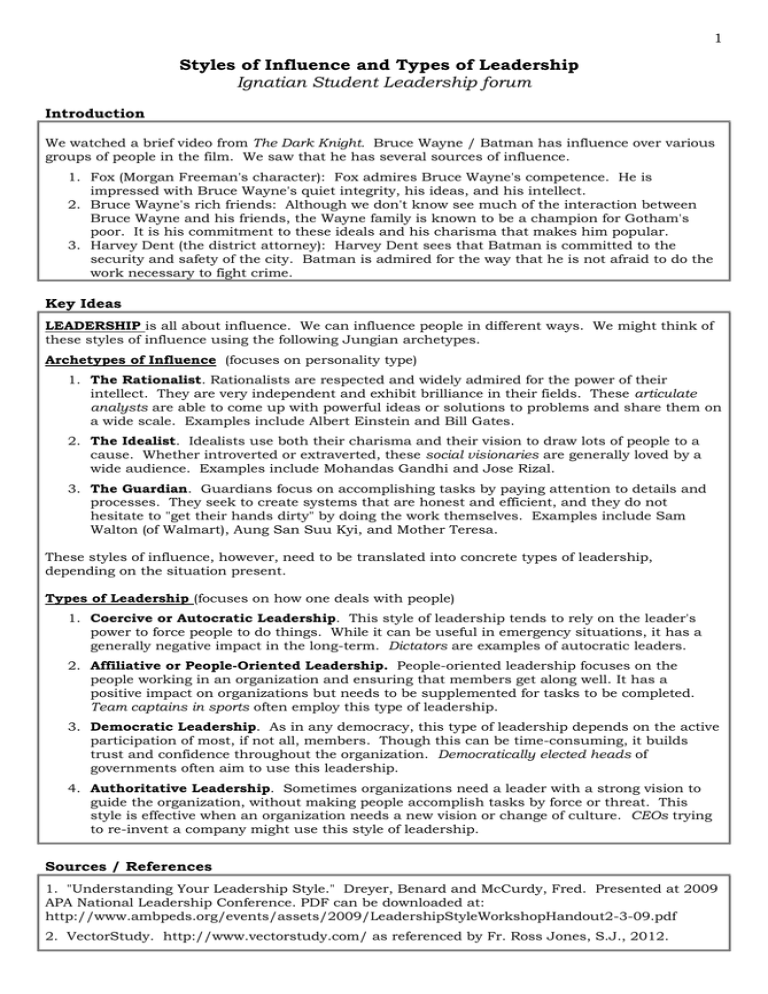File
advertisement

1 Styles of Influence and Types of Leadership Ignatian Student Leadership forum Introduction We watched a brief video from The Dark Knight. Bruce Wayne / Batman has influence over various groups of people in the film. We saw that he has several sources of influence. 1. Fox (Morgan Freeman's character): Fox admires Bruce Wayne's competence. He is impressed with Bruce Wayne's quiet integrity, his ideas, and his intellect. 2. Bruce Wayne's rich friends: Although we don't know see much of the interaction between Bruce Wayne and his friends, the Wayne family is known to be a champion for Gotham's poor. It is his commitment to these ideals and his charisma that makes him popular. 3. Harvey Dent (the district attorney): Harvey Dent sees that Batman is committed to the security and safety of the city. Batman is admired for the way that he is not afraid to do the work necessary to fight crime. Key Ideas LEADERSHIP is all about influence. We can influence people in different ways. We might think of these styles of influence using the following Jungian archetypes. Archetypes of Influence (focuses on personality type) 1. The Rationalist. Rationalists are respected and widely admired for the power of their intellect. They are very independent and exhibit brilliance in their fields. These articulate analysts are able to come up with powerful ideas or solutions to problems and share them on a wide scale. Examples include Albert Einstein and Bill Gates. 2. The Idealist. Idealists use both their charisma and their vision to draw lots of people to a cause. Whether introverted or extraverted, these social visionaries are generally loved by a wide audience. Examples include Mohandas Gandhi and Jose Rizal. 3. The Guardian. Guardians focus on accomplishing tasks by paying attention to details and processes. They seek to create systems that are honest and efficient, and they do not hesitate to "get their hands dirty" by doing the work themselves. Examples include Sam Walton (of Walmart), Aung San Suu Kyi, and Mother Teresa. These styles of influence, however, need to be translated into concrete types of leadership, depending on the situation present. Types of Leadership (focuses on how one deals with people) 1. Coercive or Autocratic Leadership. This style of leadership tends to rely on the leader's power to force people to do things. While it can be useful in emergency situations, it has a generally negative impact in the long-term. Dictators are examples of autocratic leaders. 2. Affiliative or People-Oriented Leadership. People-oriented leadership focuses on the people working in an organization and ensuring that members get along well. It has a positive impact on organizations but needs to be supplemented for tasks to be completed. Team captains in sports often employ this type of leadership. 3. Democratic Leadership. As in any democracy, this type of leadership depends on the active participation of most, if not all, members. Though this can be time-consuming, it builds trust and confidence throughout the organization. Democratically elected heads of governments often aim to use this leadership. 4. Authoritative Leadership. Sometimes organizations need a leader with a strong vision to guide the organization, without making people accomplish tasks by force or threat. This style is effective when an organization needs a new vision or change of culture. CEOs trying to re-invent a company might use this style of leadership. Sources / References 1. "Understanding Your Leadership Style." Dreyer, Benard and McCurdy, Fred. Presented at 2009 APA National Leadership Conference. PDF can be downloaded at: http://www.ambpeds.org/events/assets/2009/LeadershipStyleWorkshopHandout2-3-09.pdf 2. VectorStudy. http://www.vectorstudy.com/ as referenced by Fr. Ross Jones, S.J., 2012.





